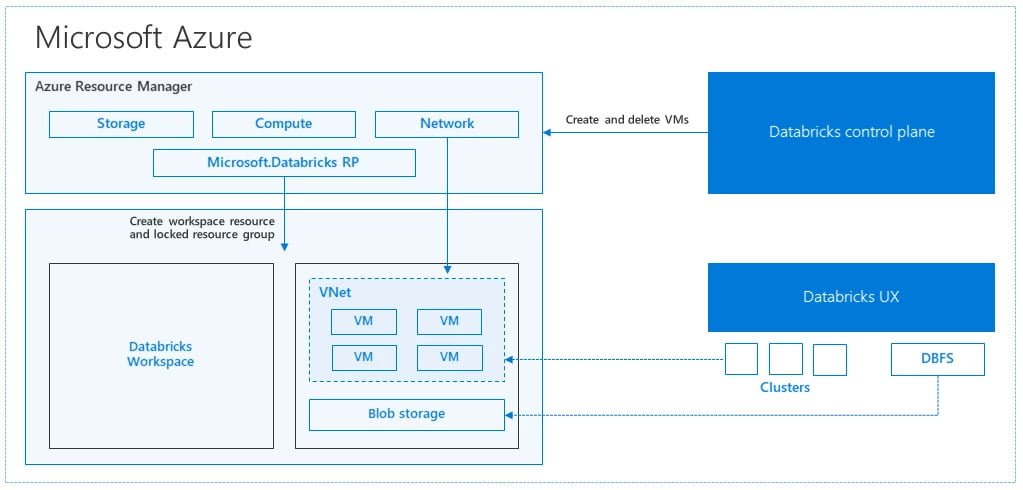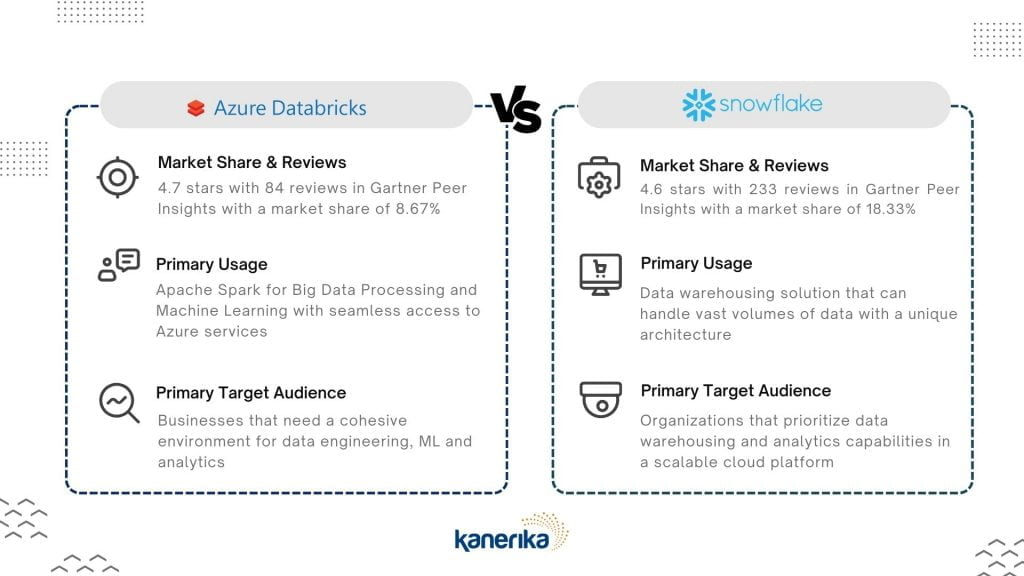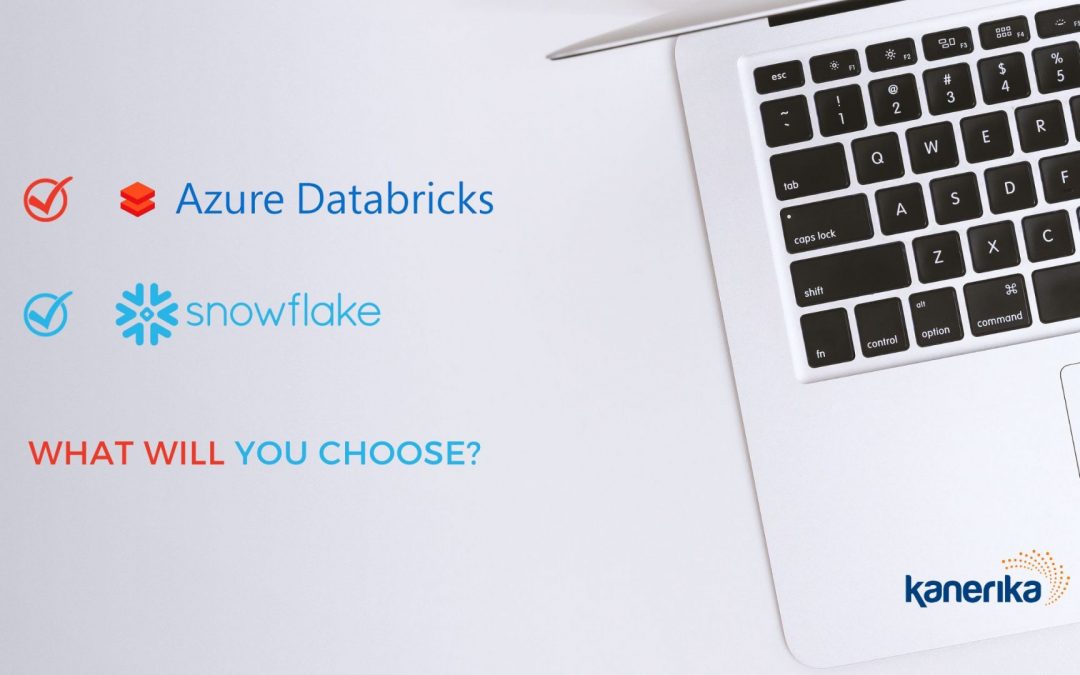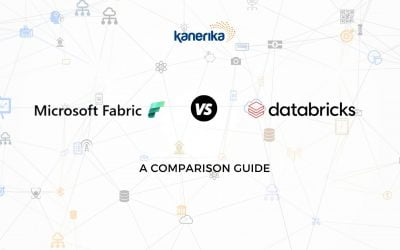The growth of cloud data analytics platforms has been on the rise, and two platforms have emerged as leading contenders: Azure Databricks and Snowflake.
Both offer robust solutions for big data processing, analytics, and machine learning. But they serve distinct purposes and have unique architecture. While one excels at simplifying big data requirements for companies, the other is a fully fledged data warehouse solution. Both are crucial in data management and analytics but differ due to their unique sets of features and capabilities.
In this article, we will explore Azure Databricks vs Snowflake and provide insights into which technology is the right choice for your business.
- What is Azure Databricks?
- What is Snowflake?
- Azure Databricks vs Snowflake: Use Cases
- Azure Databricks vs Snowflake: Architectural Differences
- Azure Databricks vs Snowflake: Performance Metrics
- Azure Databricks vs Snowflake: Pros and Cons
- Azure Databricks vs Snowflake: Comparison Table
- Azure Databricks and Snowflake – Which One is Right for You?
- The Need for a Trustworthy Implementation Partner in Data Analytics
- Partner with Kanerika and Scale your Data Analytics
- FAQs
What is Azure Databricks?
Azure Databricks is a cloud-based big data analytics service provided by Microsoft in collaboration with Databricks. It offers an Apache Spark-based analytics platform optimized for Azure, designed to simplify big data.
Key Features of Azure Databricks:
- Integrated Workspace: Collaborative notebooks support languages like Python, Scala, SQL, and R for joint work between data scientists and engineers.
- Azure Integration: Seamlessly integrates with Azure services, including Blob Storage, Data Lake Storage, SQL Data Warehouse, and Cosmos DB.
- Performance: Uses Databricks Runtime for enhanced Spark workload speeds and performance.
- Auto-scaling & Termination: Clusters adjust based on workload and terminate when inactive to optimize resources and costs.
- Security: Features Azure Active Directory integration, encryption, role-based access, and private VNET deployment.
- Real-time Analytics: Supports stream processing for real-time data analysis.
- AI & ML Integration: Collaborates with Azure Machine Learning and other libraries for comprehensive machine learning tasks.
- Managed Service: Automates cluster provisioning, patching, and backup, allowing users to focus on analytics.
- Visualizations: Offers interactive visualizations within notebooks for data exploration.
- Delta Lake: Supports Delta Lake for reliable big data workloads and enhanced performance.
What is Snowflake?
Snowflake is a fully-managed, cloud-based data warehouse that enables organizations to store, analyze, and share their data. It is built on a unique architecture that separates storage and compute. This feature allows it to scale independently and perform well on workloads of all sizes.

Source: Snowflake
Key Features of Snowflake:
- Architecture: Snowflake uses a unique multi-cluster architecture that separates storage, compute, and services, allowing each to scale independently.
- Performance: Offers automatic scaling and performance optimization, ensuring fast query results without manual tuning.
- Zero Management: As a fully managed service, Snowflake handles infrastructure management, optimization, and tuning, allowing users to focus on data analysis.
- Data Sharing: Enables secure and easy data sharing between Snowflake users in real-time without data movement.
- Concurrency: Handles multiple concurrent users and workloads without performance degradation.
- Security: Provides robust security features, including end-to-end encryption, role-based access control, and multi-factor authentication.
- Data Formats: Supports semi-structured and structured data formats, including JSON, Avro, and Parquet.
- Integration: Integrates seamlessly with popular data integration, BI, and AI/ML tools.
- Time Travel: Allows users to access historical data, enabling them to view and restore earlier versions of the data.
- Elasticity: Instantly and automatically scales up or down based on the workload, optimizing costs and performance.
Read More: Defeating bad data in 2023, saving millions every year
Read More – Databricks Vs Snowflake: Choosing Your Cloud Data Partner
Azure Databricks vs Snowflake: Use Cases
Both Azure Databricks and Snowflake offer solutions for big data processing and analytics. However, they cater to slightly different needs.
Azure Databricks is more focused on providing a Spark-based platform for big data processing and machine learning, while Snowflake is centered around data warehousing with extended capabilities for data engineering, AI/ML, and industry-specific solutions.
Azure Databricks:

Source: Microsoft
- Big Data Processing: Azure Databricks provides a platform for data engineering and data science teams to process large datasets using Spark.
- Machine Learning: With its integration with Spark MLlib, Azure Databricks allows data scientists to build and train machine learning models at scale.
- Real-time Analytics: Azure Databricks supports stream processing, enabling real-time analytics on data as it arrives.
- Collaborative Analytics: The platform offers collaborative notebooks that allow data scientists, data engineers, and business analysts to work together in an interactive environment.
- Integration with Azure Services: Databricks integration with various Azure services, such as Azure Active Directory, SQL Data Warehouse, and Power BI, makes it easier for businesses to leverage their existing Azure infrastructure.
How Companies Use Azure Databricks
Many international organizations are using Azure Databricks, and they have greatly benefited from Databricks’ many features. One such example is AT&T, which has reported an 80% decrease in fraud attacks as well as millions of dollars saved in potential fraud attacks thanks to their combined use of Lakehouse, Delta Lake, and machine learning in Azure Databricks.
Another successful example is financial giant HSBC, which used a combination of Delta Lake, data science, machine learning, and ETL to achieve a 4.5x improvement in engagement on their finance app. This was made possible due to the advanced analytics offered by Azure Databricks,whicht took 6 seconds to perform complexanalytics,s which earlier took 6 hours.
Read More: Data-Driven Healthcare: Achieving Success With Analytics And BI
Snowflake:
- Data Warehousing: Snowflake provides a platform for storing, processing, and analyzing large volumes of structured and semi-structured data.
- Data Lake: Snowflake supports flexible architectural patterns, allowing organizations to deploy governed and optimized storage at scale.
- Data Engineering: With Snowflake, data engineers can build reliable, continuous data pipelines in the language of their choice.
- Data Applications: Developers can build and scale data-intensive applications without the operational burden.
- AI/ML Workflows: Snowflake integration in AI and ML workflows provide fast access and elastically scalable processing.
- Cybersecurity: Snowflake offers unified data solutions for cybersecurity, providing near-unlimited visibility and powerful analytics to protect enterprises.
How Companies Use Snowflake
Snowflake’s complete virtual setup and easy to use architecture make it a favorite amongst businesses whose primary purpose is a data warehousing solution. Pizza Hut is a customer of Snowflake, and they use their technology to process their data and get personalized insights from it within short spans of time.
Leveraging tools like Python, R, and Spark, data scientists in Pizza Hut’s team sift through the data, employ machine learning techniques, and then funnel their findings back into Snowflake. This advanced predictive analysis ensures that consumers are presented with the most relevant messages and promotions.
Another example would be logistic companies, Porter, which saw a 90% reduction in data refresh time for daily reporting after switching to Snowflake, as well as up to 99% availability of data assets compared to 80–85% previously.
Azure Databricks vs Snowflake: Architectural Differences
Both Azure Databricks and Snowflake emphasize the decoupling of storage and compute, allowing for flexible scaling and optimized costs. However, their architecture differs due to the difference in their primary functions and structure.
Azure Databricks:
Azure Databricks is built on the Apache Spark open source engine. It has a three-layer architecture that decouples storage, compute, and control:
- Storage: Azure Databricks stores data in Azure Blob Storage, which is a highly scalable and durable object storage service.
- Compute: Azure Databricks uses Azure Databricks Clusters to process data. These clusters are composed of virtual machines that can be scaled up or down to meet your needs.
- Control: Azure Databricks provides a control plane that manages clusters and provides access to data and tools.
Snowflake Architecture:

Source: Snowflake
Snowflake has a two-layer architecture that decouples storage and compute:
- Storage: Snowflake stores data in its own proprietary storage layer. This storage layer is highly scalable and durable.
- Compute: Snowflake uses virtual warehouses to process data. These virtual warehouses are composed of virtual machines that can be scaled up or down to meet your needs.
Read More: On-Demand Webinar: Applying the power of Agile to Analytics Project
Azure Databricks vs Snowflake: Performance Metrics
In November 2021, a dispute arose between Databricks and Snowflake regarding the performance benchmarks of their respective data warehousing solutions.
Context of Azure Databricks’ claim against Snowflake
On November 2, 2021 Databricks claimed the official world record for the fastest data warehouse with their SQL platform. This claim was audited and reported by the official Transaction Processing Performance Council (TPC).
Snowflake’s Counterclaim against Azure Databricks
Snowflake responded to Databricks’ announcement by suggesting that their platform had roughly the same performance as Databricks SQL. They presented benchmarks that seemed to support their claims. However, Databricks pointed out potential discrepancies in Snowflake’s approach, especially concerning the use of pre-baked TPC-DS datasets.
Databricks’ Response to Snowflake
To address Snowflake’s counterclaims, Databricks reproduced the TPC-DS benchmarks on Snowflake’s platform. Their findings indicated that Snowflake’s pre-baked TPC-DS dataset closely matched their claims. But using an official TPC-DS dataset resulted in longer benchmark times than what Snowflake had reported.
Databricks emphasized that their approach to benchmarking was centered on real-world scenarios, ensuring optimal performance.
But who was right? Was Databricks justified in claiming that it was the better technology? Let’s explore it in the next section with a quick Pros and Cons list for each tech.
Azure Databricks vs Snowflake: Pros and Cons
Azure Databricks:
Its most significant advantage lies in its ability to seamlessly blend with the Azure ecosystem and its unified platform that allows users to combine data science, engineering as well as AI. However, larger operations may end up costing much higher on Azure Databricks due to its complex structure.
| Pros | Cons |
|---|---|
| Unified Platform: Combines data engineering, data science, and AI. | Cost: Can be expensive for large-scale operations. |
| Azure Integration: Seamless operations within the Azure ecosystem. | Complexity: Steeper learning curve for those unfamiliar with Spark. Supports Microsoft Azure and AWS. |
| Optimized Performance: Enhanced speed for Spark workloads. | |
| Real-time Analytics: Supports stream processing. | |
| ML Integration: Direct integration with popular ML libraries. |
Snowflake:
Its greatest asset lies in its maintenance-free and highly scalable solution that requires very little intervention from the team once the pipeline is setup. However, its limited ML support can hinder the scale of its operations for organizations that require more in-depth machine learning.
| Pros | Cons |
|---|---|
| Scalability: Independent scaling of storage and compute. | Limited ML Support: Relies on third-party integrations for ML. |
| Data Sharing: Easy and secure data sharing between accounts. | Cost: Pricing based on virtual warehouse usage can add up. |
| Versatile Data Handling: Supports structured and semi-structured data. | |
| Auto-scaling: Adjusts resources based on workload. | |
| Maintenance-Free: Fully managed service. |
Azure Databricks vs Snowflake: Comparison Table
Here’s a quick table to compare all the high-level points between Azure Databricks and Snowflake:
| Feature | Azure Databricks | Snowflake |
|---|---|---|
| Azure Databricks vs Snowflake Service Model | Unified, open analytics platform for building, deploying, sharing, and maintaining enterprise-grade data, analytics, and AI solutions at scale. | Cloud-based data warehousing platform built on top of Azure and AWS Cloud platforms. |
| Azure Databricks vs Snowflake Major Cloud Platform Support | Supports Microsoft Azure and Amazon Web Services (AWS). | Supports Microsoft Azure and AWS. |
| Azure Databricks vs Snowflake Scalability | Offers fully managed Apache Spark environment with the global scale and availability of Azure. | Provides optimized storage with unsiloed access to any data at near-infinite scale, including data outside of Snowflake. |
| Snowflake vs Databricks User-Friendliness | Supports Python, Scala, R, Java, and SQL. Databricks integrates with frameworks and libraries such as TensorFlow, PyTorch, and scikit-learn. | Supports SQL, Python, Scala, Java, and R programming languages. Integrates with the latest versions of Apache Spark and open source libraries. |
| Snowflake vs Databricks Data Structures | Handles structured data using Dataframes and Spark SQL libraries. Supports unstructured data such as images, videos, audio files, etc. | Stores structured data in a relational database format. Supports semi-structured data such as JSON or XML files. |
| Azure Databricks vs Snowflake Pricing | Pricing based on the number of virtual machines (VMs) used for computation and storage used for data. Offers a 14-day free trial without any upfront commitment. | Pricing based on the amount of storage used for data and the time spent querying that data. Offers a 30-day free trial without any upfront commitment. |
| Snowflake vs Azure Databricks Query Interface | Provides Collaborative Notebooks for coding in languages like Scala, R, SQL, Python, etc. | Offers Snowflake Web Interface (SWI) for querying data using SQL commands and provides a command-line interface (CLI) called SnowSQL for querying data using SQL commands. |
| Snowflake vs Azure Databricks Machine Learning Support | Supports machine learning frameworks such as TensorFlow, PyTorch, scikit-learn, etc. | Does not provide built-in machine learning capabilities but can integrate with third-party machine learning tools such as TensorFlow or PyTorch. |
Azure Databricks and Snowflake – Which One is Right for You?

According to Gartner Peer Insights, Databricks has a rating of 4.7 stars with 84 reviews, while Snowflake has a rating of 4.6 stars with 233 reviews in the Cloud Database Management Systems market.
Databricks vs Snowflake market share tilts in favor of the latter. Snowflake has a market share of 18.33% while Databricks has a market share of 8.67%.
If your priority is a platform that offers seamless integration with Azure services, coupled with the power of Apache Spark for big data processing and machine learning, Azure Databricks is the solution you might lean towards. It’s particularly suited for businesses that need a cohesive environment for data engineering, machine learning, and analytics, with features like real-time analytics and collaborative notebooks.
Conversely, if you’re in search of a robust data warehousing solution that can handle vast volumes of structured and semi-structured data with a unique architecture that separates storage and compute, Snowflake stands out.
Snowflake’s cloud-based nature ensures scalability for diverse workloads, and its features like data sharing in real-time and Time Travel make it a compelling choice for organizations that prioritize data warehousing and analytics capabilities.
The Need for a Trustworthy Implementation Partner in Data Analytics
Enterprises looking to benefit from data analytics have to be very specific about their need for the technology. Do they qualify as a large or small business? What storage requirements would their data require? Is Azure Databricks better for them, or is Snowflake a more apt solution?
From choosing the right data framework to setting up systems that can handle the right volumes and types of data, the entire process of setting up and running a data analytics solution can be complex without prior knowledge and experience. This is why it is important for businesses to choose the right data analytics implementation partners to work with. Here’s what such a partnership brings to the table:
Read More: Operational Analytics: Implementation and Benefits for Data Teams
1. Experience-Driven Process
A seasoned implementation partner offers a methodology that’s been honed over multiple successful projects. Such expertise accelerates deployment, reduces risks, and ensures avoidance of common implementation challenges.
2. Comprehensive Toolset and Frameworks
A reputable consulting firm is well-versed in the latest data analytics technologies. Their deep industry knowledge ensures that the analytics solutions are tailored to specific business needs, all while adhering to industry standards and regulations. This is especially crucial for sectors with stringent compliance requirements, like healthcare or insurance.
3. Domain Expertise
Partnering with a firm that possesses a broad array of frameworks and tools can significantly enhance an enterprise’s analytics capabilities. These tools cover all aspects of the implementation process, from data collection and analysis to continuous monitoring and maintenance.
4. Change Management Support
Implementing new technology often necessitates organizational change, which can be daunting. A competent partner will provide change management assistance, ensuring a smooth transition. This encompasses staff training, best practice guidelines, and strategies to seamlessly integrate the new technology into the existing organizational framework.
Partner with Kanerika and Scale your Data Analytics

Both Azure Databricks and Snowflake are powerful and scalable analytics platforms. But which unified analytics platform is right for your business? And how do you customize and integrate it seamlessly?
Kanerika can help you make those important decisions and guide your entry into data analytics. With over twenty years of unmatched expertise in data management, AI/ML, and generative AI, we are uniquely positioned to guide you through the ever-changing world of data analytics.
Our strategic alliances, especially as a proud Microsoft Gold Partner and Snowflake Partner, grant us direct implementation access and deep insights into tools like Azure Synapse, Azure Databricks, Snowflake and the advanced suite of Microsoft Fabric. Kanerika not only amplifies and optimizes your existing infrastructure but also ensures that you’re consistently ahead in the technological race.
Choose Kanerika and amplify your data operations today!
1. Should I use Databricks or Snowflake?
What is the difference between Databricks and Snowflake?
3. Why Databricks is better than Snowflake?
4. What are the three layers of Databricks?
5. What is the advantage of Azure Databricks?
6. What is the alternative of Snowflake?









